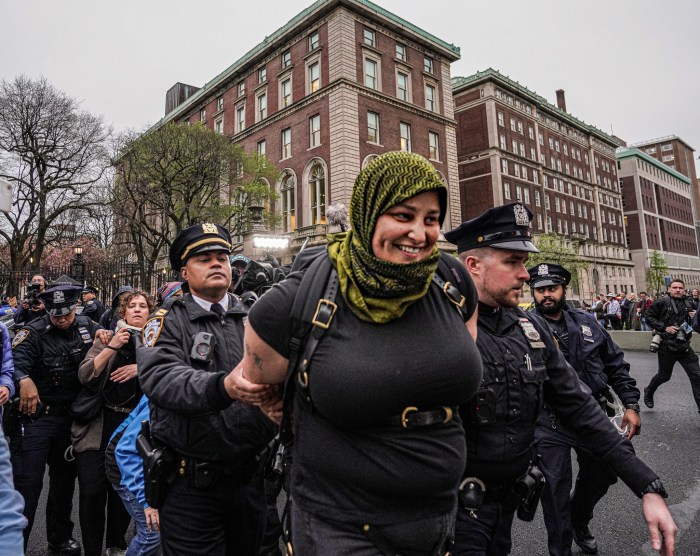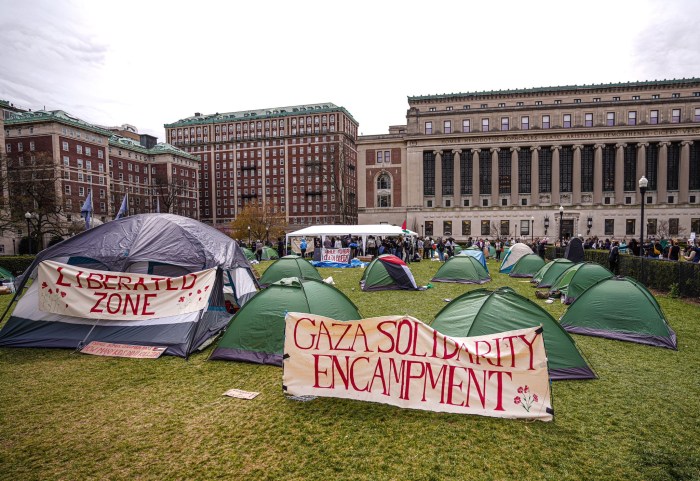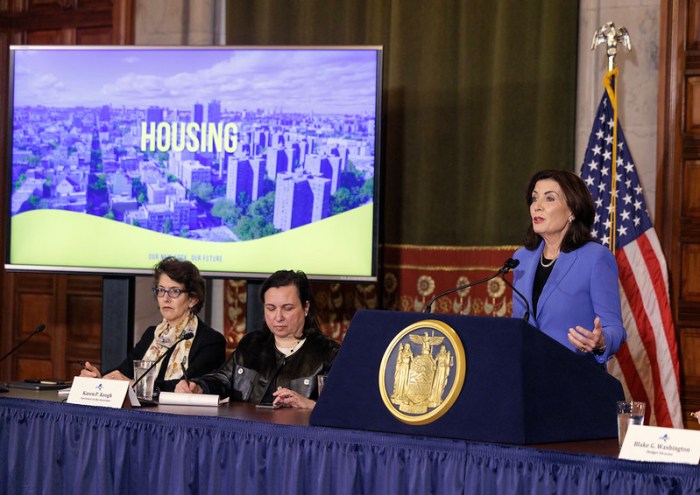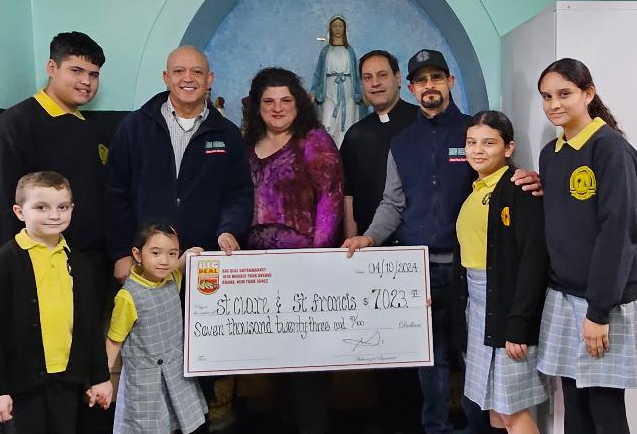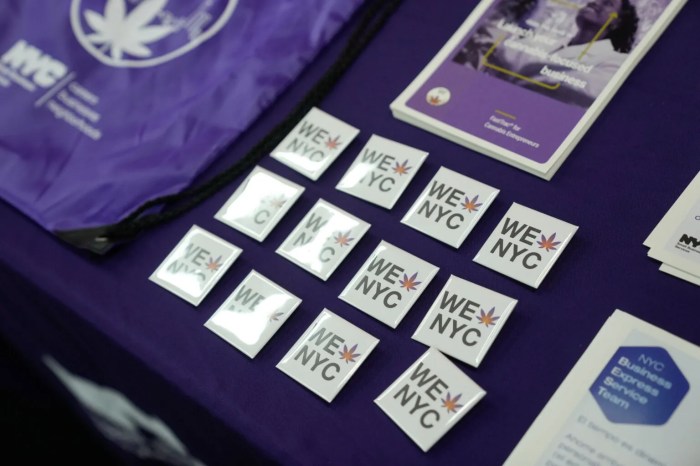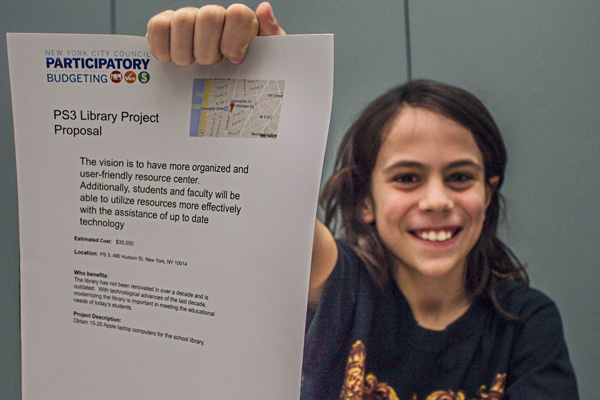
Aidan Collins, 10, stepped into the role of point man for the proposal to renovate the library at PS3 — item #6 on your Participatory Budgeting ballot.
BY ZACH WILLIAMS | With election time fast approaching, residents of Chelsea and Hell’s Kitchen gathered at a March 24 Expo to present beautification, repair and upgrade projects set to appear on the Participatory Budgeting ballot.
Seventeen projects will vie for support in voting to be held from April 11-19, with the top vote-getters receiving funding until the cumulative amount reaches the $1 million allocated by Councilmember Corey Johnson’s office.
There was no clear front-runner among the proposals seen at the Andrew Heiskell Braille and Talking Book Library (40 W. 20th St.) — but certain advantages and strategies were apparent at the event, which attracted about 100 potential voters.
This is the first time District 3 has taken part in the process since Participatory Budgeting was established in 2011, as an option of how to spend discretionary funding distributed from the city’s capital budget (Johnson’s office was given approximately $5 million).
Current City Council Speaker Melissa Mark-Viverito was one of the four who opted in during that first year. Currently, 24 districts are taking part. Matt Green, a legislative aide to Councilmember Johnson who also serves as the office’s Participatory Budget Director, told Chelsea Now that the jump happened in part because the process has become “more institutionalized, with more resources and staff.”
Johnson told Expo attendees that he hopes several thousand people will participate in voting, which is open to anyone who lives Council District 3 and is at least 14 years old. “I don’t have all the answers and I shouldn’t be the only person in charge of determining what is important and what needs to be funded,” said Johnson. “This is democratizing the budget process.”
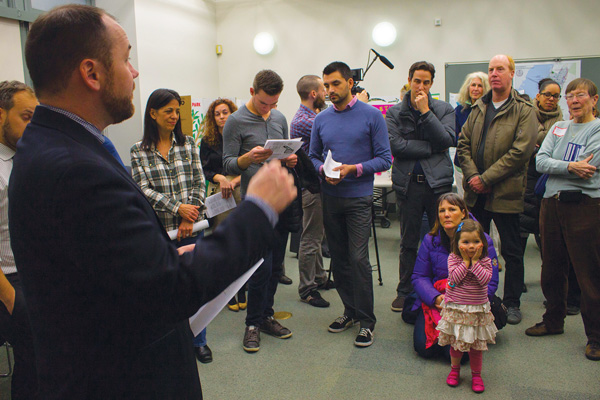
This is the first year that District 3 residents have voted for how $1 million in funding from the office of Councilmember Corey Johnson (left, addressing crowd) could be used to further community interests.
There was no shortage of ideas in response. Parks, schools, streets, libraries, bus stops and composting received attention in the process. Two proposals set their sites on the most private of public spaces: bathrooms. Different approaches to campaigning at the event included touting streetscape innovations, the involvement of young people in proposals and even a bit of candy to entice prospective voters to one display.
One proposal seemed to benefit when its delegate was unable to attend the meeting. Ten-year-old Aidan Collins stepped into the role of point man for a $100,000 plan to renovate bathrooms at PS3 as well as a $35,000 idea to bring computers to the school located at 490 Hudson Street. Boys’ bathrooms at the school lack mirrors, he added.
Across the room, 14-year-old Liam Buckley stumped for restroom renovations and a new public address system at the Lab School (333 W. 17th St.). Participatory budgets gave the ideas a fresh chance for funding after other options failed, he said, a situation similar to other proposals.
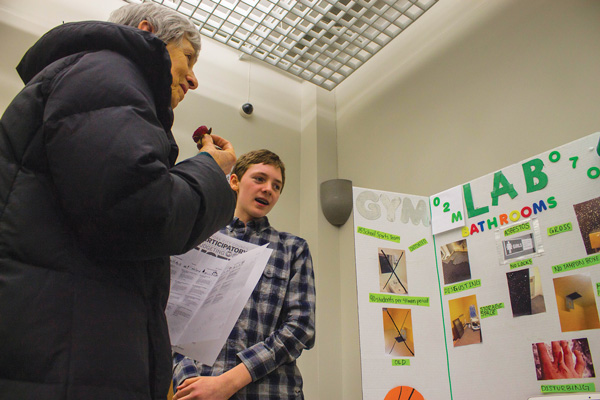
“The bathrooms are definitely dirty and outdated. The floors are slanted. There’s urinals missing and there are no locks on the door. We hope this is the last time that we have to address this for years to come,” said Buckley.
However, the money game has its own role to play in persuading voters.
The lowest proposal on the ballot requests $35,000 with the highest at $560,000. Representatives of proposals with higher costs expressed concern that estimates were set too high and might jeopardize their chances in the upcoming election if voters think such a large project would crowd out multiple cheaper options.
Some projects could receive funding even if they do not prevail in voting. What matters is that ideas with strong community support receive attention, said Johnson. He added in an interview that no final decisions have been made yet on how his office will spend $4 million in other discretionary funding.
Local transportation safety advocacy group Clinton Hell’s Kitchen Coalition for Pedestrian Safety (CHEKPEDS) has hopes that they could install a prototype of a raised pedestrian crossing in Hell’s Kitchen at the intersection of W. 45th St. and Ninth Ave. The crossing would increase visibility for pedestrians, slow down traffic as well as maintaining water drainage. But the CHEKPEDS proposal has competition among transportation-minded voters in the form of a $200,000 proposal to install countdown clocks for the M11 and M12 buses.
Estimates from the city put the cost of the CHEKPEDS project at $250,000 though research showed that costs could be significantly less, according to Christine Berthet, co-founder of CHEKPEDS and chair of Community Board 4.
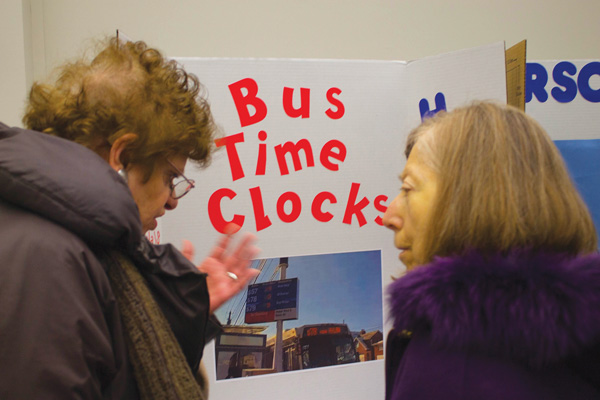
Higher price tags could also prevent other worthy projects from acquiring funding, said Patrick Shields, a South Village resident who wants a new turf soccer field in Fulton Houses on W. 17th St. Costs could be minimized should the proposal win, allowing funds to be used elsewhere, he added while expressing a concern about just how the cost of the proposal was determined to be $500,000.
“Whether it was purposely over-budgeted I don’t know. I don’t think so. I hope not, but I’m going to assume not and lobby like crazy,” he said. Supporters of professional soccer will come out to canvas in support, he added. The site is the only place available in District 3 able to accommodate such a sports field for local youth, according to Shields.
“It’s off the street. It’s in between buildings. It’s sandwiched where they aren’t going to be running into the street chasing balls,” he said.
Voters can support up to five projects which will be given equal weight in tallying results. This could help second and third choices emerge victorious if voters are more split about their top choice. Marking just one or two choices for projects on the ballot might help boost their chances, suggested Bill Borock, president of the Council of Chelsea Block Associations. He indicated support for a proposal which would fund both demolition and an environmental impact study for a new park on W. 20th St.
That effort has been ongoing for five years, said Pamela Wolff, a member of Chelsea’s West 200 Block Association.
“There’s some real stick-to-it-iveness among the people who very much have their hearts in it,” she said.
Another idea for local public spaces is revitalizing Chelsea Waterside Park. Not only would the installation of an interactive garden benefit local children, but the space also serves as an important physical link between the High Line and Hudson River Park, said Zazel Loven who is on the board for Chelsea Waterside Park.
The biggest factor in determining the winners of the Participatory Budgeting election could be voter turn-out in support of each of the 17 proposals. With tens of thousands of potential voters, delegates said they would focus on mobilizing their own supporters through community groups, canvassing and phone banking rather than contesting the merits of other projects.
Negotiating the Participatory Budgeting process takes time and organization. With voting just weeks away, delegates said that they have to shift gears and focus on the campaign for votes, but many expressed confidence that their own coalitions of block associations and other civic groups would help them win, but their work is cut out for them.
“We were a little freaked out about that. We didn’t realize that there has to be concerted effort to get people out to vote,” Loven said.
A workshop held the week before by Friends of the High Line helped prepare project proponents for the campaign, according to Erycka Montoya, community engagement coordinator. She, along with all participants at the event interviewed by Chelsea Now, praised the Participatory Budgeting process for not only allocating money for community capital projects, but also catalyzing new forms of civic engagement among all ages.
Undecided voters — including Johnson — said at the event that they will have to think more about the relative merits of each proposal before casting their ballots. The March 24 event, though, gave guidance to Gabrielle Dann-Allel on narrowing down her choices, she said.
“I’ve learned a lot about the needs of the library, which are major, and a lot about the funding process and about the needs of Fulton Housing, which I found very interesting. I think I’m torn between the needs of those two spheres,” said Dann-Allel.
VOTING LOCATIONS
Voting takes place April 11 – 19
Text “VOTE” to 212-676-8384
for your closest poll site.
Councilmember Johnson’s District Office
224 W. 30th Street, Suite 1206
April 13-17 | 10 a.m.-5 p.m.
Tony Dapolito Recreation Center
1 Clarkson St.
April 11, 12, 18, 19 | 9 a.m.–6 p.m.
The Fulton Houses Tenants Association Office
419A W. 17th St.
April 11, 12, 18 and 19 | 9 a.m.–6 p.m.
Hartley House
413 W.46th St.
April 11, 12, 18, 19 | 9 a.m.–5:30 p.m.
Hudson Guild (Dan Carpenter Room, 2nd Fl.)
441 W. 26th St.
April 12 & 19 | 9 a.m.–6 p.m.
The LGBT Community Center
208 W. 13th St.
April 18 & 19, 9 a.m.–6 p.m.
Pop-up voting sites will also appear throughout the district. Text “PBNYC” to 212-676-8384 for more info.
ON THE BALLOT
#1 Cooling System for Muhlenberg Library ($500,000)
Funding would replace the building’s HVAC cooling unit (the library serves as an official NYC Cooling Center)
#2 Renovations for Jefferson Market Library ($500,000)
Funding would go towards renovating the lobby bathroom to make it ADA-compliant.
#3 O. Henry Learning Campus Renovations ($290,000)
Hudson Guild, Lab High School, Lab Middle School and Museum School will benefit from new gym bleachers, gym scoreboard and locker room bathroom renovations.
#4 Bathroom Renovations at Lab School ($560,000)
Project would renovate two student bathrooms on each floor and bathrooms adjacent to the cafeteria.
#5 Bathroom Renovations for PS3 ($100,000)
Renovation of existing bathroom facilities to promote a more sanitary environment for students, faculty and school visitors.
#6 PS3 Library Renovations ($35,000)
With the technological advances of the last decade, modernizing the library is important in meeting the educational needs of today’s students.
#7 Public Address System Upgrade ($500,000)
PA system repair and upgrades to support the needs of three separate schools in the building, as well as building-wide announcements.
#8 New Park for the Community ($200,000)
Transform the vacant lot on W. 20th St. into a public park for the community. Project would go towards demolishing the former Department of Sanitation building and environmental cleanup.
#9 Revitalization of Chelsea Waterside Park ($85,000)
The project would bring residents into this underused park by creating an interactive garden for local children, focusing on ethnobotany and native plants.
#10 Downing Playground & Fountain Upgrades ($200,000)
Playground upgrades with new play equipment for children, as well as a safer, more child-friendly drinking fountain to replace the aging concrete structure that is currently falling apart.
#11 Community Composting Center ($35,000)
A year-round solar-powered, forced air composting system for residents of Hell’s Kitchen would have the capacity for at least two compost drop-off days per week.
#12 New Soccer Turf Field at Fulton Houses ($500,000)
New soccer turf, including physical safety and ball-strike safety fence or netting for neighboring window safety, marked field and durable permanent mini-goals.
#13 Resurfacing Sprinklers at Fulton Houses ($345,000)
The toddler sprinkler area is used extensively but needs to be excavated and resurfaced with the right materials so children can continue to enjoy it and play safely.
#14 Upgrading Fulton Houses Basketball Court ($425,000)
This project will offer all residents access to a modern basketball court. Court requires pavement to be leveled, drainage correction, proper landscaping and court markings.
#15 Pedestrian Safety: Raised Crosswalks ($250,000)
Help prevent further crashes, deaths and injuries for pedestrians by installing a speed table at the notoriously dangerous crosswalk at W. 45th St. & 9th Ave.
#16 Bus Time Clocks for the M11 & M12 ($200,000)
Installation of clocks that will provide waiting passengers with time information and bus arrival times (along M11 & M12 routes).
#17 Sidewalk Repair/Replacement ($50,000)
The sidewalk on W. 26th St. (btw. 9th & 10th Aves.) is in desperate need of repair. It has become difficult to walk, push carriages and wheelchairs on the sidewalk.











